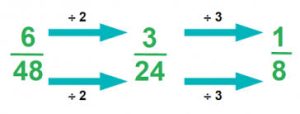4 Converting Between Decimals and Fractions
In the bakery, sometimes it is more useful to use a fraction, and sometimes it is more useful to use a decimal number. It is often helpful or necessary to convert between one and the other.
You can convert a fraction to a decimal by dividing the top number by the bottom number. For example, = 1
4 = 0.25.
To take it the other way, 0.25 can be converted back to a fraction by noticing the last decimal place, in this case, hundredths. You would put the decimal number over that number, giving you . From here you would reduce the fraction. This is done by dividing both the top and bottom numbers by the same number. Both numbers divide by 25. 25
25 = 1, and 100
25 = 4. So the answer reduces to
.
It’s possible to reduce a fraction using more than one step, if you can’t figure out the largest number that will divide into both the top and bottom numbers. It’s fine to do that as long as in the end you have a fraction reduced as far as possible.

Here is a link that will convert a decimal to a fraction: Decimal to Fraction You may use it for assignments and quizzes in this course after we have completed this unit.
It’s also helpful to memorize how some common fractions are expressed as decimals:
| 0.125 | |
| 0.25 | |
| 033* | |
| 0.375 | |
| 0.5 | |
| 0.625 | |
| 0.67* | |
| 0.75 | |
| 0.875 |
*Not exact. Rounded to nearest hundredth.
This puts an anchor at the top of the page to link to within the page.
This is the Navigation section at the top of the page.
Assignment
Purpose
To practice converting between fractions and decimals.
Outcomes
By completing this assignment, you will be able to…
- Convert from a fraction to a decimal.
- Convert from a decimal to a fraction, reducing to the lowest terms.
Instructions
To complete this assignment…
- Read the problems carefully and find the correct answers.
- Be sure to show how you set up each problem. You may use a calculator to do the basic division calculations, but you must show how each problem or fraction reduction is set up.
Tips for Success
To help in the completion of this assignment, make sure to:
- Round any decimals to the nearest hundredth if necessary.
- Reduce fractions to the lowest terms.
- Include how you set up each problem in order to get credit.
Decimals and Fractions Assignment
Convert to a decimal number. Round to the nearest hundredth if necessary:
1)
2)
3)
4)
5)
6)
7)
8)
Convert to a fraction or mixed number. Reduce to lowest terms if necessary:
9) 0.8
10) 2.4
11) 3.5
12) 1.25
13) 0.75
14) 4.125
15) 3.3125
16) 0.25
17) 8.5
18) 3.625
19) 12.6
20) 2.375

